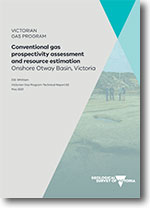VGP Technical Report 62 - Conventional gas prospectivity assessment and resource estimation, Onshore Otway Basin, Victoria
 |
| |||||||||||||||
Product description:About the Victorian Gas Program: The Victorian Gas Program (VGP) is a comprehensive science-led program, incorporating geoscientific and environmental research to assess the risks, benefits and impacts of potential onshore conventional gas exploration and production. The program is also investigating the potential for further discoveries of onshore conventional and offshore gas in the Otway and Gippsland geological basins and assessing the feasibility of additional onshore underground gas storage in depleted reservoirs around the Port Campbell area. The VGP includes an extensive, proactive and phased community and stakeholder engagement program, through which the results of the scientific studies are being communicated. Executive summary: The conventional gas resources in the Victorian portion of the onshore Otway Basin have been assessed as part of the Victorian Gas Program (VGP). The evaluation has integrated new geoscientific studies conducted under the VGP geoscience program with pre-existing data and interpretations to identify the areas of the onshore Otway Basin where future conventional gas discoveries are likely and the potential volume of conventional gas that remains to be found has been estimated. Previous exploration has proved the Otway Basin to be a gas-prone hydrocarbon province. Approximately 2.5 TCF (trillion cubic feet) of gas has been found, the majority of which is located offshore in Cretaceous-aged Waarre Formation reservoir rocks. Gas accumulations have been discovered in the Waarre Formation in onshore Victoria and the adjacent three-nautical-mile zone, and in the older Pretty Hill Formation in South Australia. Post-drill analysis of the 177 exploration wells drilled in the project area (which includes adjacent areas of South Australia and seaward areas in less than 200 m of water) shows that historically, roughly one in every three wells (36%) in the basin has encountered hydrocarbons. This assessment is based on the identification and evaluation of related geological circumstances that control the distribution of hydrocarbon accumulations in the subsurface and are known as a play. A play is the timely combination of reservoir and seal rocks with petroleum charge and potential traps to produce hydrocarbon accumulations in a basin. Ten plays, defined by reservoir interval, are identified in the Otway Basin and the likely presence and effectiveness of the key geological components of each play (reservoir, seal, charge and trap) have been assessed and mapped. The individual play element maps are combined (stacked) into a play fairway map, which shows the likely presence of the required geological conditions for gas accumulation for each play. The play fairway maps have been combined to create a composite map of the prospectivity for conventional gas in the Otway Basin. A proven play fairway is an area (often with known gas fields) where there is high confidence that all elements of the play are present. Parts of the fairway where the occurrence or effectiveness of one or more components of the play is ambiguous constitute a possible play fairway. The size of these areas and an estimate of feature density determines the likely number of traps that are yet to be drilled. The extent of the prospective play fairways is chiefly determined by the location of areas where effective reservoir rocks overlie mature source rocks in either the Crayfish Subgroup or the Eumeralla Formation that have continued to expel hydrocarbons during the last 20 million years. The assessment highlights the Port Campbell Embayment and Penola Trough areas where future gas discoveries are most likely to occur. The coastal areas of southwestern Victoria between Portland and the border with South Australia and the southern parts of the Tyrendarra Embayment are also prospective. The prospective area around Port Campbell extends into the three-nautical-mile zone immediately offshore and into deeper water underlain by the Shipwreck Trough. The quantity of gas that might be found in the basin by future exploration has been predicted by estimating the range of uncertainty in the number of potentially gas-bearing traps remaining to be drilled in each proven and possible play fairway and their likely size distribution (as recoverable gas resources). These estimates have been combined stochastically by Monte Carlo simulation to generate a resource distribution for each play and for the combined the plays. The prospective conventional gas resources attributed to all plays in the onshore Otway Basin in Victoria has a low (P90) estimate of 294 BCF (billion cubic feet) and a high (P10) estimate of 660 BCF, with a mean 458 BCF. These estimates are discounted by the assessed likelihood of success to yield an expected resource distribution with a P90, P10 and mean of 81 BCF, 189 BCF and 131 BCF respectively with the ratio of successful wells in the mean case of 28%. The Pretty Hill play accounts for approximately half of the yet-to-find resources, with the Waarre play (upper and lower) representing 15% and the Sawpit making up 11% of the total. Low, mid and high case exploration and production scenarios were developed from these prospective resource estimates and used in modelling the risks, benefits and impacts of a conventional upstream gas industry in Victoria. Bibliographic reference: Whittam, D.B., 2021. Conventional gas prospectivity assessment and resource estimation, Onshore Otway Basin, Victoria. VGP Technical Report 62. Geological Survey of Victoria, Department of Jobs, Precincts and Regions, Melbourne, Victoria. Download: The downloadable version of this report is supplied in PDF format (36 MB), Att A1 ESRI™ GIS data (ZIP 55 MB) & Att A2 (ZIP XLSX 2.5 MB). Related products:
| ||||||||||||||||


